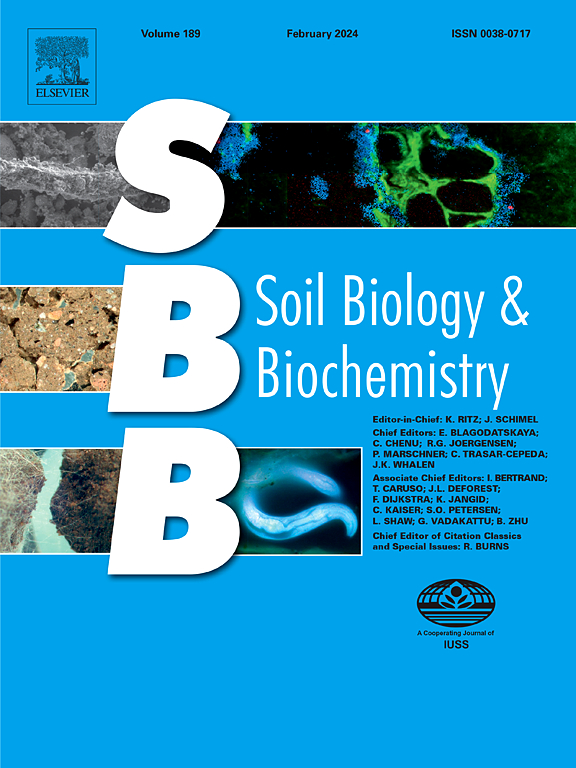土壤生物群对农业管理措施的响应:系统定量元数据分析和方法选择框架
IF 9.8
1区 农林科学
Q1 SOIL SCIENCE
引用次数: 0
摘要
土壤生物对土壤健康至关重要,但将其纳入监测框架的情况仍然有限。然而,众所周知,农业管理做法对土壤生物群及其所支持的功能有显著影响。本文系统地评价了碳与养分、植被、病虫害和土壤管理以及放牧管理对土壤生物群的影响。使用元数据分析方法,我们系统地回顾了元分析,以量化管理实践对土壤生物行为者的影响,包括大型动物、中生态动物、微型动物和微生物组。我们鉴定并筛选了698篇文章,其中90篇荟萃分析在质量控制和冗余分析后仍然合格,共产生790个成对组合,由774526个观察结果支持。在本文中,我们展示了具体的管理措施如何影响特定的土壤生物群,这反过来也可能影响这些土壤生物群支持的土壤过程和功能。我们揭示了关键的知识差距,特别是关于土壤中、大型动物,以及土壤原生动物。我们的研究展示了哪些农业实践可能支持或破坏土壤生物学,为选择可持续农业方法提供了急需的指导,如减少耕作、有机施肥、覆盖种植和间作。最后,我们为土壤参与者引入了“效用-稳健性”评分系统,使用系统框架为特定管理环境量身定制的生物指标选择提供信息。随着新数据和新见解的出现,这种完全透明的方法将在未来几年保持适应性和可扩展性。本文章由计算机程序翻译,如有差异,请以英文原文为准。
Response of soil biota to agricultural management practices: A systematic quantitative meta-data-analysis and method selection framework
Soil organisms are vital to soil health, however, their inclusion in monitoring frameworks remains limited. Yet, it is well-known that agricultural management practices distinctively affect soil biota and the functions that they support. In this paper, we systematically evaluated the impact of management practices related to carbon and nutrient, vegetation, pest and disease and soil management, as well as grazing management on soil biota. Using a meta-data analysis approach, we systematically reviewed meta-analyses to quantify management practice(s) effects on soil biological actors, including macrofauna, mesofauna, microfauna, and the microbiome. We identified and screened 698 articles, of which 90 meta-analyses remained eligible after quality control and redundancy analysis, giving rise to a total of 790 pairwise combinations supported by 74′526 observations. In this paper, we demonstrate how specific management practices impact specific soil biota, which in turn may also influence soil processes and functions that these soil biota support. We reveal key knowledge gaps, particularly concerning the soil meso- and macrofauna, but also soil protists. Our study demonstrates which agricultural practices may support or diminish soil biology, providing much needed guidance on the selection of sustainable farming approaches, such as reduced tillage, organic fertilization, cover cropping, and intercropping. Lastly, we introduce a “Utility-Robustness” scoring system for soil actors, using a systematic framework to inform biological indicator selection tailored to specific management contexts. This fully transparent approach is designed to remain adaptable and expandable in the coming years, as new data and insights emerge.
求助全文
通过发布文献求助,成功后即可免费获取论文全文。
去求助
来源期刊

Soil Biology & Biochemistry
农林科学-土壤科学
CiteScore
16.90
自引率
9.30%
发文量
312
审稿时长
49 days
期刊介绍:
Soil Biology & Biochemistry publishes original research articles of international significance focusing on biological processes in soil and their applications to soil and environmental quality. Major topics include the ecology and biochemical processes of soil organisms, their effects on the environment, and interactions with plants. The journal also welcomes state-of-the-art reviews and discussions on contemporary research in soil biology and biochemistry.
 求助内容:
求助内容: 应助结果提醒方式:
应助结果提醒方式:


